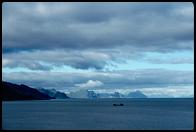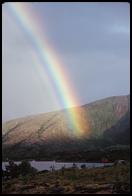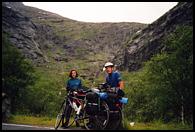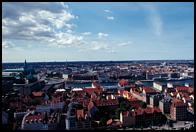

|
Norway and Denmark |
It's strange to look back on Norway five months later. I sit in my room organizing the slides, and it almost feels as if I'm looking at someone else's trip. Recalling what I really felt like---by turns excited, tired, dusty, sweaty, happy, lonely---requires conscious effort.




Northern Norway was, above all things, empty. The scenery was like nothing I had seen before. The sun never set, yet light and weather changed constantly, sometimes producing wonderful effects. The first two days the sun shone brilliantly: the only problem was a fierce wind, which either slowed me down to almost walking pace, or pushed me and my loaded touring bike up significant inclines at over 30km/h without my having to pedal.

The vast empty stretches of northern Finnmark, dotted with the occasional reindeer, gave way to more mountainous, fjord-like terrain. Unfortunately, the weather turned foul, too. In Tromsø, after almost a week of riding, I decided that I had had enough. Cold despite all my thermal gear, and soaked by freezing drizzle, I boarded a ferry and headed a little way south to Harstad, on the Vesteralen Islands.


The two-hour ferry ride turned out to be a great idea. After one last shower, the weather more or less held up (with just occasional sprinkles) for a couple of days. Even better, on one of the ferry crossings on the Vesteralen Islands I met Berni, a German cyclist. He was great company, and we traveled together for several days until Trondheim, where he took the train back to Germany, and I met up with Rosalba.




The Lofoten Islands are breathtakingly beautiful, rugged and wild. Lofty mountains dominate the horizon, yet the air is saturated with the smell of the ocean and broken by the cry of seagulls. I hope to return an do them more justice when I'm a better photographer.


Stamsund is one of the main harbors on the Lofoten Islands. Berni and I arrived there around lunch time. We bought some food at a grocery store, then cycled on and followed signs to the tourist information center. We ended up on a desolate pier facing some sort of fuel storage facility. There was nothing there---certainly no tourist info center---except for a large Michelin "X" tire of the kind used by earth-moving equipment. This made for an excellent (if seagull-soiled) table, so we brought out the food, turned away from the fuel storage, and enjoyed the view while we ate lunch.


Back on the mainland, we cycled south from Bodø along route 17, a panoramic route through wild and jagged coastline. The weather was freezing and wet, but occasionally we were rewarded by spectacular sights.


Three hundred kilometers later, still no improvement in the weather. Despite the cold, I couldn't help being awed by this region's beauty.

Berni and I parted in Trondheim, and I cycled on with Rosalba. Rosalba enjoyed one day of sunshine. Note, however, the windswept trees in this photo.





However, by the time we reached Trollstigen, "the Troll road," the weather was appropriately gloomy. The white sky and low, clinging clouds perfectly complemented the intimidating cliff that we were climbing.

After a day of steep climbs and descents, we reached Geiranger, one of Norway's most picturesque fjords.




The sky cleared in the morning, affording magnificent views.



Eleven hundred meters above Geiranger lies a lake surrounded by sparkling snowfields.

The Lom stave church is an important example of Norwegian religious architecture. Like other stave churches, it mixes Christian elements with pagan symbology predating Norway's 11th-century religious conversion. It is made entirely of wood, and it is over 500 years old. I loved the fragrant smell of the interior, and the wood's worn, organic appearance.


Sognefjell is a cold and inhospitable place. The road is Norway's highest, and it passes by some of the country's largest glaciers. I wasn't taking many pictures up there: both of my tires exploded on that day, and I ended up having to hitchhike the last few miles to Turtagrø. Rosalba and I cycled for a while with Isha, a friendly man from Connecticut who provided a lot of support when my tires failed.



The tire failure was the low point in my entire trip. I couldn't find any spares in the small town of Sogndal, so the only alternative was to skip the last 200km of road to Bergen and take the ferry instead. In Bergen I found bicycle spare parts, as well as colorful architecture and a spectacular fish market.

After a massive downpour throughout the previous day, our last day in Norway began with a rainbow. As I write this and look at the photos I want to go back, but my diary makes it very clear that at the time I was quite happy to leave that sodden place.


In Denmark there are no reindeer. And Rosalba only had to wear her rain jacket once.




We cycled across Denmark mostly from northwest to southeast, so the wind was usually in our favor. There's nothing like rolling through wide-open countryside at the speed of the wind. The land moves by quickly but the air is still all around you. There is great silence; you can talk with a cycling companion without raising your voice. I could cycle like this for hours and hours and never be tired of the feeling.


Stressed by bicycle commuting in an American city? Try Copenhagen,
where bicycles take up a full lane on main roads, and people will stop
to help you if you have a flat.
Go on to the slide show from Poland.
| Top |